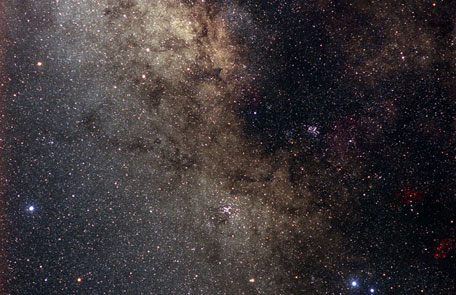Night
comes slowly during
the summer. During late June and early July, the sun doesn't set until
9:20 pm and twilight doesn't end until 11:30 pm! This can be difficult
for stargazers that have to work the next morning. The summer night sky
is well worth staying up for though. The Milky Way, a faint band of
light made up of innumerable stars, arcs across the sky. If bright
lights are nearby, from a large city or your neighbor's yard, the Milky
Way may be invisible. From a dark sky site, the Milky Way will make a
lasting impression on you. After all, what you see is your home galaxy
overhead.
On a clear, moonless night find an observing site with a dark southern
sky. The "central bulge" of our galaxy will be in the south at about
midnight during early summer. Make sure you're well prepared before you
venture under the stars. Pack a cool drink, insect spray, a flashlight
(with red light), a star chart, and a pair of binoculars. Yes, that's
right - binoculars! You'll be amazed with what you can see through a
pair of 7×50 or 10×50 binoculars. Binoculars are
the ultimate tool for
scanning the Milky Way's rich star clusters and glowing nebulae
(clouds) of dust and gas.
Scorpius "the Scorpion" is one of the most recognizable constellations
and is due south at midnight during early summer. The most notable star
in this constellation is the red supergiant Antares, which means "rival
of Ares", the ancient Greek god of war (Mars in Roman mythology). To
the west of Antares, a nearly vertical line of three stars forms the
head of the scorpion. The scorpion's tail forms a hook that skims just
above the treetops. The tip of the hook forms the scorpion's deadly
stinger.
![[Scorpius]](images/stargazing/scorpius.jpg) Scorpius as seen from a
very dark location in West Texas.
Scorpius as seen from a
very dark location in West Texas.
Point your binoculars at Antares and then move the red giant to the
upper left of your field-of-view. Look for a small ball of light; this
is the globular cluster M4, a collection of tens of thousands of stars
7000 light-years away. Through a telescope M4 is astonishing, more
stars than you could possibly count in one night. Next, follow the tail
stars until you come to Mu Scorpii, a lovely double star. Move slightly
south of Mu and you're sure to stumble across NGC 6231, a collection of
30 stars. This entire region is packed with stars from lesser clusters.
Just below NGC 6231 is another double star, Zeta Scorpii.
Follow the tail all the way to the stinger star, Shaula, and then pan
to the east. The magnificent open cluster M7 will nearly fill your
field-of-view. Over a dozen blue and white stars are visible; several
concentrated in the cluster's center with several more in the outer
boundaries. With M7 in the center of your field, slowly pan to the
northwest and you'll come across M6, another open cluster. It's smaller
than M7, but still a delightful sight in binoculars. See if you can
place both clusters in your binoculars' field-of-view.
 Open clusters M6
(right of center) and M7 (below center).
Open clusters M6
(right of center) and M7 (below center).
I leave the rest of the Milky
Way's summer delights to you. Follow the Milky Way from Scorpius in the
south to "W" shaped Cassiopeia
in the northeast. You're sure to discover several of our
galaxies secret places along the way.
![[Star-Hopping in the Scorpion]](images/stargazing/scorpion.jpg)
![[Star-Hopping in the Scorpion]](images/stargazing/scorpion.jpg)